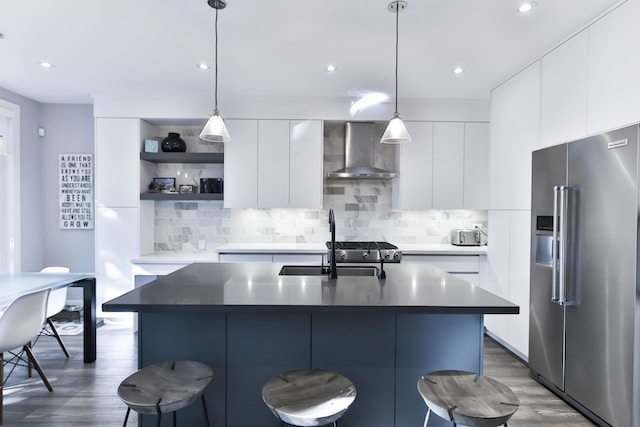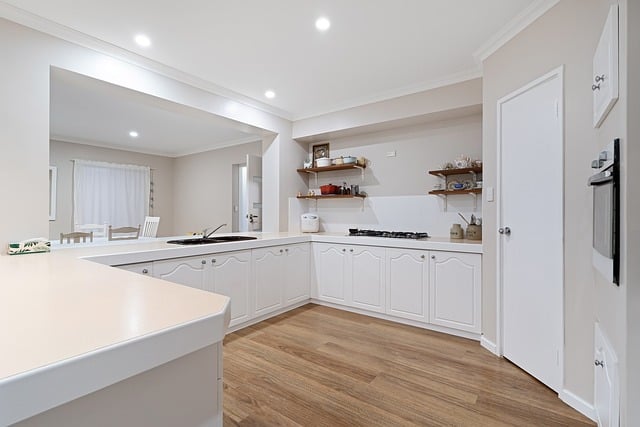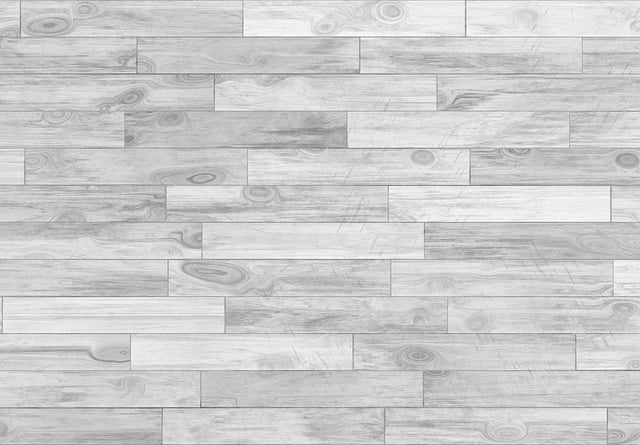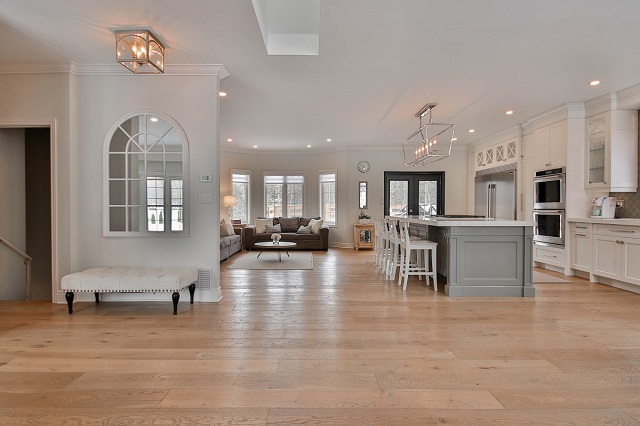10 Most Popular Home Improvements That Add Value
When it comes to selling a home, making the right improvements can significantly increase its value and attract potential buyers. Whether you’re planning to sell your home in the near future or simply want to enhance its overall appeal, here are the top 10 home improvements that are known to add value for resale:
- Kitchen Remodel: The heart of any home, a kitchen remodel is one of the most popular improvements that can greatly impact a home’s value. Upgrading appliances, installing new countertops, and enhancing the overall layout can make a tremendous difference in attracting buyers.
- Bathroom Renovation: Another prime area for potential buyers, a well-designed bathroom can significantly increase a home’s value. By adding modern fixtures, replacing old tiles, and incorporating energy-efficient features, you can create a luxurious and desirable space.
- Outdoor Enhancements: Improving your home’s curb appeal is crucial in making a lasting first impression. Enhancements such as landscaping, a fresh coat of paint, and a well-maintained lawn can make your home stand out and increase its value.
- Energy-Efficient Upgrades: In today’s environmentally conscious world, energy-efficient upgrades have become highly desirable. These may include installing solar panels, energy-saving windows, or adding insulation to improve your home’s energy efficiency and lower utility costs.
- Adding a Deck or Patio: Outdoor living spaces have gained immense popularity in recent years. Adding a deck or patio not only extends the living space but also creates an inviting area for entertaining and relaxation.
- Upgrading the Garage: The garage is often overlooked but can be a major selling point for potential buyers. Installing organization systems, modernizing the door, and improving the overall functionality of the space can greatly boost the value of your home.
- Basement Remodel: Converting an unfinished basement into a usable space can significantly increase your home’s value. Whether it becomes a home office, a recreational area, or a spare bedroom, a finished basement adds extra square footage and appeals to a wider range of buyers.
- Installing Smart Home Technology: With technological advancements, buyers are increasingly interested in homes that offer smart features. Incorporating smart thermostats, security systems, and lighting can not only increase your home’s value but also improve convenience and energy efficiency.
- Enhancing the Entryway: The first thing a potential buyer sees when entering your home is the entryway. Enhancing it with a fresh coat of paint, modern light fixtures, and a functional storage area can create a welcoming and memorable first impression.
- Updating the Flooring: Old, worn-out flooring can be a major turn-off for buyers. Installing new, high-quality flooring can instantly transform the look and feel of your home, increasing its value in the process.
The Importance of Curb Appeal in Home Improvements
When it comes to home improvements, one aspect that should not be overlooked is curb appeal. This refers to the attractiveness of a property’s exterior, including its landscaping, architecture, and overall appearance. Curb appeal plays a crucial role in creating a positive first impression and can greatly affect the value of a home. Whether you are planning to sell your property or simply want to enhance its overall appeal, investing in curb appeal can yield significant returns.
First impressions matter, and when potential buyers or visitors approach your home, the exterior is the first thing they see. A well-maintained and visually appealing exterior creates a sense of pride and can make your home stand out from the competition. It sets the tone for what potential buyers can expect inside and can greatly influence their perception of the property’s value. Therefore, it is essential to prioritize curb appeal when considering home improvements.
There are several ways to enhance curb appeal, starting with landscaping. Well-manicured lawns, neatly trimmed hedges, and colorful flowers can instantly transform a property’s appearance. Planting trees strategically can also provide shade and add visual interest. Additionally, consider adding outdoor lighting to highlight key features and increase safety and security.
The exterior of the house itself should also be maintained and improved. Repainting the exterior can give the property a fresh and updated look. Choosing a color scheme that complements the neighborhood and enhances the architectural style of the home is important. Installing new windows and doors can also improve energy efficiency and enhance the overall aesthetics.
Another factor to consider when enhancing curb appeal is the driveway and walkways. Cracks or stains can detract from the beauty of a property, so it is important to repair or replace them if necessary. Installing decorative elements such as pavers or adding a walkway to the front door can provide a welcoming and visually appealing entrance.
Incorporating outdoor living spaces has become increasingly popular and can greatly enhance curb appeal. Adding a patio, deck, or porch can create additional usable space for entertaining and relaxing. Including outdoor furniture and accessories can paint a picture of how potential buyers can envision themselves enjoying the space.
Cost-Effective Home Improvements for Increasing Home Value
When it comes to home improvements, finding cost-effective solutions that increase the value of your home is paramount. Not only will these upgrades enhance your living space, but they will also have a positive impact on your resale value. By carefully choosing the right projects, you can achieve maximum return on investment (ROI) without breaking the bank.
One of the most effective ways to boost your home’s value without overspending is by focusing on the kitchen. The kitchen is often considered the heart of the home and is a major selling point for potential buyers. Start by giving your cabinets a fresh coat of paint or refinishing them to make them look brand new. Installing modern, energy-efficient appliances not only enhances the aesthetic appeal but also adds value to your home. Additionally, replacing outdated countertops with more durable and visually appealing materials, such as quartz or granite, can make a significant impact.
Another cost-effective home improvement project that adds value is bathroom renovations. Similar to the kitchen, bathrooms play a crucial role in the overall appeal of a home. Consider replacing old fixtures with water-saving options to attract environmentally conscious buyers. Upgrading your bathroom by installing a new vanity, adding a frameless glass shower screen, or updating the tiles can give it a fresh and modern look.
Energy-efficient upgrades are not only environmentally friendly but can also save you money in the long run. Adding insulation to your attic and walls can greatly improve your home’s energy efficiency and appeal to potential buyers. Furthermore, upgrading to energy-efficient windows and doors can increase your home’s value while reducing heating and cooling costs. These upgrades are not only cost-effective but also offer long-term benefits.
Enhancing your home’s curb appeal is another cost-effective way to add value. Simple tasks, such as painting the exterior, planting flowers, and maintaining the landscaping, can dramatically improve the overall appearance of your home. Additionally, replacing your front door or updating the garage door can instantly transform the look of your house and make a lasting impression.
Key Considerations When Choosing Home Improvement Projects
When it comes to improving your home, there are countless options to consider. Whether you’re looking to update your kitchen, add a new bathroom, or create a more energy-efficient space, the choices can be overwhelming. However, before diving into any home improvement project, it’s important to take a step back and consider a few key factors. These considerations will help ensure that you select the right project that aligns with your needs, budget, and the overall value you hope to achieve.
1. Determine Your Goals
Before starting any home improvement project, it’s essential to identify your goals. Ask yourself what you hope to achieve with the renovation. Are you looking to enhance your living space, increase your home’s energy efficiency, or boost its resale value? Understanding your objectives will help guide your decision-making process and allow you to prioritize certain projects over others.
2. Assess Your Budget
No matter the size of your renovation, it’s crucial to set a budget and stick to it. Assess your finances and determine how much you can comfortably allocate towards your improvement project. Remember to consider potential unforeseen expenses that may arise during the renovation process. Having a clear budget in mind will help you narrow down your options and prevent overspending.
3. Research the ROI
To ensure you’re making a sound investment, research the potential return on investment (ROI) for the projects you’re considering. Not all home improvements yield the same level of return when it comes time to sell your property. Focus on projects that have a proven track record of adding value to homes, such as kitchen remodels or bathroom additions. By prioritizing projects with a high ROI, you can maximize the value of your home and make a more informed decision.
4. Consider Long-Term Maintenance
When selecting a home improvement project, it’s essential to factor in long-term maintenance requirements. Some projects may add value to your home initially but could become costly and time-consuming to maintain over the years. Carefully consider whether you have the time, resources, and willingness to handle ongoing upkeep. Opting for low-maintenance projects can save you stress and money in the long run.
5. Think About Market Demand
If you’re renovating with the intention of selling your home in the future, it’s crucial to consider market demand. Research the current trends and preferences of potential buyers in your area. Understanding what homebuyers are looking for can help you choose improvements that will appeal to a wider audience, increasing the chances of a successful sale when the time comes.
6. Consult with Professionals
Lastly, don’t hesitate to seek professional advice when choosing your home improvement project. An architect, contractor, or real estate agent can offer valuable insights into the potential value and feasibility of certain renovations. They can guide you through the decision-making process and provide expert recommendations tailored to your specific circumstances.
Tips for Maximizing the Return on Investment for Home Improvements
Home improvements are not only a way to enhance your living space, but they can also significantly increase the value of your home. However, it is important to approach these projects strategically to ensure that you get the maximum return on your investment. Here are some tips to help you maximize the return on investment for your home improvements:
- Focus on the kitchen and bathroom: These are two of the most important rooms in a home and can greatly impact its value. Upgrade your kitchen with modern appliances, energy-efficient fixtures, and stylish countertops. In the bathroom, consider installing a new shower, bathtub, or vanity to give it a fresh and luxurious look.
- Improve energy efficiency: Energy-efficient features are highly sought after by homebuyers. Consider incorporating energy-saving measures such as installing solar panels, upgrading insulation, and using energy-efficient appliances. These improvements not only add value to your home but also result in long-term savings on energy bills.
- Enhance curb appeal: First impressions matter, and the exterior of your home is the first thing potential buyers will see. Invest in landscaping, paint the exterior of your home, replace the front door, and upgrade the driveway and walkways. These improvements can significantly enhance the curb appeal of your home and make it more appealing to potential buyers.
- Upgrade the flooring: Replace outdated carpets with hardwood, laminate, or tiles to give your home a fresh and modern look. High-quality flooring not only adds value but also has a long lifespan, making it an investment that pays off in the long run.
- Opt for neutral colors: When making any cosmetic changes to your home, choose neutral colors for paint, flooring, and fixtures. Neutral colors appeal to a wider range of buyers and allow them to envision themselves living in the space. Avoid trendy or bold colors that may limit the appeal of your home.
- Make use of extra space: Utilize any unused space in your home to create additional living areas. This can include finishing the basement, adding an attic conversion, or converting a garage into a usable space. Extra living areas provide added functionality and appeal to potential buyers.
- Address maintenance issues: Fix any maintenance issues in your home before putting it on the market. This includes repairing leaky faucets, replacing broken windows, and fixing any structural issues. A well-maintained home not only fetches a higher price but also gives buyers confidence in the overall condition of the property.
- Consider smart home technology: Incorporating smart home technology can add both convenience and value to your home. Install programmable thermostats, smart lighting systems, and security features that can be controlled remotely. These features are not only attractive to buyers but also showcase the modernity and efficiency of your home.
- Seek professional advice: When planning major home improvements, it is always a good idea to consult with a professional. An experienced real estate agent or a home improvement specialist can provide insights into which improvements will yield the highest return on investment in your specific market.
- Stay within budget: While it is important to make strategic improvements to increase your home’s value, it is equally important to stay within your budget. Do thorough research, obtain multiple quotes, and prioritize the improvements that will have the greatest impact. Avoid overspending on unnecessary upgrades that may not provide a significant return on investment.
Conclusion
In today’s real estate market, where buyers are increasingly discerning and competitive, home improvements can play a vital role in increasing the value of your property. By making the right choices and prioritizing certain projects, homeowners can not only enhance the aesthetic appeal of their homes but also maximize their return on investment. As we have explored throughout this article, there are several key areas to focus on when it comes to home improvements that add value for resale.
One of the top considerations in any home improvement project is identifying the ten most popular upgrades that have proven to be effective in adding value. These can include renovations such as kitchen and bathroom remodels, adding an additional bedroom or living space, installing energy-efficient windows, or even upgrading the home’s insulation. By focusing on improvements that are most sought after by buyers, you can increase your chances of attracting potential buyers and securing a higher sale price.
Curb appeal is another critical factor to consider when undertaking home improvements. The exterior of your home is the first impression potential buyers will have, and it sets the tone for their overall perception of the property. Enhancements such as fresh paint, a well-maintained lawn, attractive landscaping, and a welcoming entrance can significantly impact the desirability of your home. Investing in curb appeal can create a lasting positive impression and increase the likelihood of buyers falling in love with your property from the moment they first lay eyes on it.
While home improvements can be exciting, it is essential to keep in mind the cost-effectiveness and potential returns on investment. It is crucial to prioritize projects that offer the most significant value in relation to their cost. For example, small-scale kitchen renovations, bathroom updates, and energy-efficient upgrades often provide excellent returns without breaking the bank. By being strategic with your spending, you can elevate your home’s value while avoiding unnecessary expenses.
Of course, before embarking on any home improvement journey, it is vital to consider certain key factors. First and foremost, you must evaluate your budget and set realistic expectations for what you can accomplish. Additionally, it is crucial to understand your local housing market and the preferences of potential buyers in your area. By aligning your chosen improvements with market demand, you can optimize your chances of attracting buyers and achieving a higher resale value.
Finally, to ensure that your home improvements yield the desired results, it is essential to employ certain tips that maximize return on investment. These can include researching and hiring reputable contractors, obtaining proper permits and licenses, setting realistic timelines, and utilizing materials and finishes that are both durable and appealing to buyers. By combining these strategies, you can ensure that your home improvements are not only aesthetically pleasing but also lucrative in terms of resale value.
In conclusion, the decision to embark on home improvements can significantly impact the value of your property for resale. By focusing on the top 10 improvements that have proven to be effective, prioritizing curb appeal, considering cost-effectiveness, evaluating key considerations, and implementing tips to maximize return on investment, homeowners can enhance their chances of securing a higher sale price and attracting potential buyers. So, start planning your home improvement journey today and unlock the full potential of your property.







